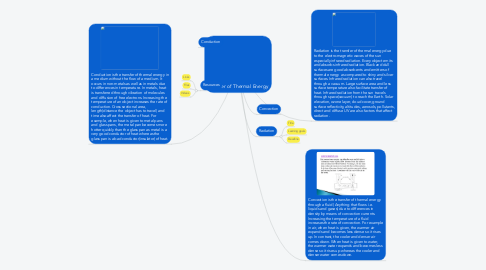Transfer of Thermal Energy
by Mohid Imran

1. Conduction is the transfer of thermal energy in a medium without the flow of a medium. It occurs in non-metals as well as in metals due to differences in temperature. In metals, heat is transferred through vibration of molecules and diffusion of free electrons. Increasing the temperature of an object increases the rate of conduction. Cross sectional area, length(distance the object has to travel) and time also affect the transfer of heat. For example, when heat is given to metal pans and glass pans, the metal pan becomes more hotter quickly than the glass pan as metal is a very good conductor of heat whereas the glass pan is a bad conductor(insulator) of heat.
2. Conduction
3. Resources
3.1. Links
3.2. Files
3.3. Videos
4. Radiation is the transfer of thermal energy due to the electro-magnetic waves of the sun especially infrared radiation. Every object emits and absorbs infrared radiation. Black and dull surfaces are good absorbents and emitters of thermal energy as compared to shiny and silver surfaces. Infrared radiation can also travel through a vacuum. Large surface area and less surface temperature also facilitate transfer of heat. Infrared radiation from the sun travels through space(vacuum) to reach the Earth. Solar elevation, ozone layer, cloud cover, ground surface reflectivity, altitudes, aerosols, pollutants, direct and diffuse UV are also factors that affect radiation.
5. Convection is the transfer of thermal energy through a fluid( Anything that flows i.e. liquids and gases) due to differences in density by means of convection currents. Increasing the temperature of a fluid increases the rate of convection. For example in air, when heat is given, the warmer air expands and becomes less dense so it rises up. In contrast, the cooler and denser air comes down. When heat is given to water, the warmer water expands and becomes less dense so it rises up whereas the cooler and denser water comes down.
6. Convection
7. Radiation
7.1. Title
7.2. Learning goals
7.3. Deadline


